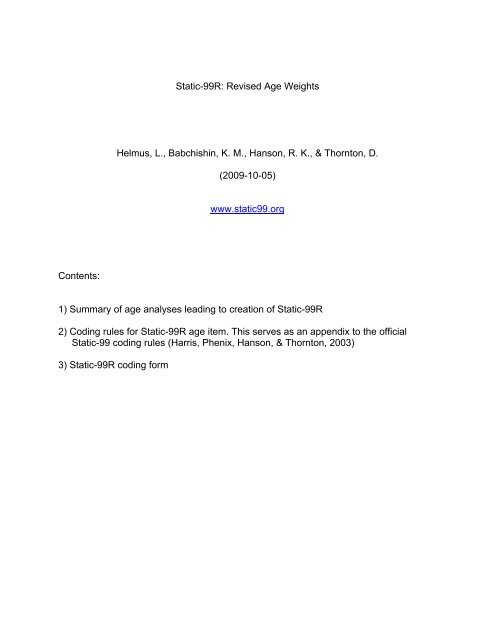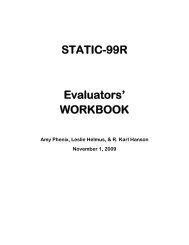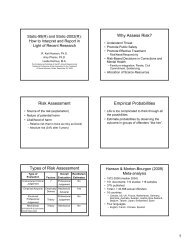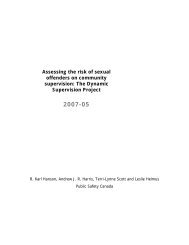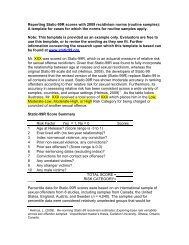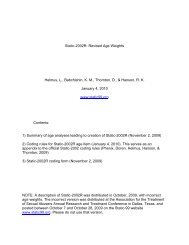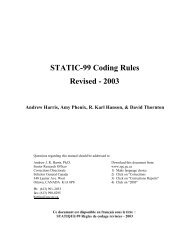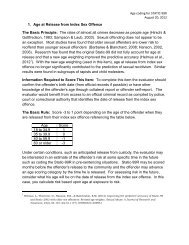Revised Age Weights - Static-99
Revised Age Weights - Static-99
Revised Age Weights - Static-99
Create successful ePaper yourself
Turn your PDF publications into a flip-book with our unique Google optimized e-Paper software.
<strong>Static</strong>-<strong>99</strong>R: <strong>Revised</strong> <strong>Age</strong> <strong>Weights</strong><br />
Helmus, L., Babchishin, K. M., Hanson, R. K., & Thornton, D.<br />
(2009-10-05)<br />
www.static<strong>99</strong>.org<br />
Contents:<br />
1) Summary of age analyses leading to creation of <strong>Static</strong>-<strong>99</strong>R<br />
2) Coding rules for <strong>Static</strong>-<strong>99</strong>R age item. This serves as an appendix to the official<br />
<strong>Static</strong>-<strong>99</strong> coding rules (Harris, Phenix, Hanson, & Thornton, 2003)<br />
3) <strong>Static</strong>-<strong>99</strong>R coding form
<strong>Age</strong> and <strong>Static</strong>-<strong>99</strong><br />
Similar to other types of crimes, sexual offending tends to decrease steadily with age<br />
(Barbaree & Blanchard, 2008; for research on general offending, see Hirschi &<br />
Gottfredson, 1983; Sampson & Laub, 2003). <strong>Age</strong> is therefore an important factor to<br />
consider in actuarial risk assessments. Although <strong>Static</strong>-<strong>99</strong> allocates some weight to age<br />
at release (offenders less than 25 years old receive 1 point), research has found that<br />
age at release still adds incremental predictive validity above <strong>Static</strong>-<strong>99</strong>, with older<br />
offenders showing less sexual recidivism (Hanson, 2006). Research with additional<br />
samples (described below) was therefore undertaken to further examine the contribution<br />
of age at release in the prediction of sexual recidivism, resulting in the development of<br />
new age weights for <strong>Static</strong>-<strong>99</strong>.<br />
<strong>Age</strong> Analyses in the <strong>Static</strong>-<strong>99</strong> Re-norming Project<br />
Information on age at release was available for 7,878 cases from 21 samples (the<br />
samples and methods are described in Helmus, 2009). Cox regression analyses were<br />
used to examine the relationship between age and sexual recidivism, with sample<br />
entered as strata (see Table 1). After controlling for <strong>Static</strong>-<strong>99</strong>, age at release had a<br />
significant negative linear relationship with sexual recidivism (χ 2 change = 28.7, df = 1, p<br />
< .001). The rate ratio was .98 (95% C. I. of .98 to .<strong>99</strong>), meaning that each one-unit<br />
increase in age was associated with 98% of the recidivism rate from the previous<br />
(younger) age. In other words, the expected recidivism rate of thirty-two year old<br />
offenders is 98% of the recidivism rate of thirty-one year old offenders, which is 98% of<br />
the recidivism rate of thirty year old offenders, and so on. The study also found a<br />
curvilinear relationship between sexual recidivism and age (χ 2 change for squared age<br />
variable = 10.7, df = 1, p = .001). Adding a cubed age variable was non-significant (χ 2<br />
change = 1.5, df = 1, p = .218), indicating that the relationship between age and<br />
recidivism does not need two curves.<br />
Further analyses were conducted to examine the shape of the distribution describing<br />
the relationship between age and recidivism (after controlling for <strong>Static</strong>-<strong>99</strong>). Figure 1<br />
presents the contribution of age and age squared to the prediction of sexual recidivism,<br />
estimated from Cox regression. The hazard ratio is centered on the mean <strong>Static</strong>-<strong>99</strong><br />
value, which is represented by a hazard ratio of 1. Figure 2 presents the same analyses<br />
using logistic regression at 5 years, with <strong>Static</strong>-<strong>99</strong> scores centered on 2 and the y axis<br />
referring to estimated recidivism rates as a percentage. Both figures demonstrate the<br />
same pattern, with a slight increase in risk for offenders in their twenties, followed by a<br />
fairly linear decrease in risk up until their eighties.<br />
The relationship between age and recidivism depicted in Figures 1 and 2 may be<br />
slightly misleading, however, given that offenders less than 25 years old are already<br />
given a risk point on <strong>Static</strong>-<strong>99</strong>. To better understand the relationship between age and<br />
recidivism, <strong>Static</strong>-<strong>99</strong> was re-computed without the age item. For offenders with <strong>Static</strong>-<strong>99</strong><br />
total scores but no individual item scores, the age-free <strong>Static</strong>-<strong>99</strong> could be computed if<br />
age information was available elsewhere in the dataset; if not, it was coded as missing.
Table 1<br />
Cox Regression Analyses Examining the Incremental Effect of <strong>Age</strong> over <strong>Static</strong>-<strong>99</strong><br />
Scores for the Prediction of Sexual Recidivism<br />
χ 2 change Regression coefficient Rate ratio<br />
change df p b SE p Exp(B) 95% C.I.<br />
Step 1<br />
<strong>Age</strong> 28.67 1
Figure 2. Recidivism as a function of age at release (using logistic regression)<br />
Figure 3. Recidivism as a function of age at release (using logistic regression and<br />
removing the age item from <strong>Static</strong>-<strong>99</strong>)
Figure 3 presents the same analysis as Figure 2, but with the age-free <strong>Static</strong>-<strong>99</strong> score.<br />
When the age item was excluded from <strong>Static</strong>-<strong>99</strong>, the relationship between age and<br />
recidivism was clearly linear. Similar results were found in Cox regression, where age<br />
added significantly to the prediction of sexual recidivism after controlling for the age-free<br />
<strong>Static</strong>-<strong>99</strong> score (χ 2 change = 48.8, df = 1, p < .001), but the squared age value did not<br />
(χ 2 change = 2.9, df = 1, p = .087). Although the curvilinear effect approached<br />
significance in the Cox Regression analysis (p = .087), a quadratic effect was not used<br />
to create new age weights because the effect was small (see Figure 3) and maintaining<br />
conservative decision thresholds was viewed as desirable in light of the large sample<br />
sizes and high-power analyses used in the current study.<br />
Analyses to Develop New <strong>Age</strong> Item of the <strong>Static</strong>-<strong>99</strong>R<br />
Rather than fitting a complicated curvilinear age adjustment to the original <strong>Static</strong>-<strong>99</strong>, a<br />
simpler option would be to develop a new age item. For this task, the overall sample<br />
was divided into two subsamples: one for the development of new <strong>Static</strong>-<strong>99</strong> age<br />
weights, and another sample for validation. Of offenders with age-free <strong>Static</strong>-<strong>99</strong> scores<br />
and information on age at release (k = 23, n = 8,128), offenders with follow-up periods<br />
of less than 10 years (k = 23, n = 5,736) were used as the development sample, and<br />
offenders with follow-up periods greater than 10 years were retained for validation (k =<br />
15, n = 2,392). This method allowed the new <strong>Static</strong>-<strong>99</strong> age weights (developed using 5-<br />
year recidivism information) to be validated with another sample at 5 years, and also<br />
permitted testing of its generalization to 10 year recidivism rates.<br />
The principles guiding the selection of the new age weights were as follows: a) each<br />
unit should approximate the <strong>Static</strong>-<strong>99</strong> units found in other analyses (rate ratio and odds<br />
ratio of approximately 1.35); b) offenders with the median age (39 years old) should<br />
receive a score of 0 for this item; c) the revised measure should have higher overall<br />
predictive accuracy than the original; and d) age should no longer contribute<br />
significantly once the <strong>Static</strong>-<strong>99</strong> scale with the new age item is included.<br />
The relationship between age and recidivism in the construction sample (n = 5,736) was<br />
explored and the following new age weights were proposed: offenders less than 35<br />
would receive 1 point on <strong>Static</strong>-<strong>99</strong>, offenders age 35 to 39.<strong>99</strong>9 would receive 0 points,<br />
offenders age 40 to 59.<strong>99</strong>9 would have 1 point subtracted from <strong>Static</strong>-<strong>99</strong>, and offenders<br />
age 60 and older would have 3 points subtracted from <strong>Static</strong>-<strong>99</strong>. The revised <strong>Static</strong>-<strong>99</strong><br />
scale with these age weights was called <strong>Static</strong>-<strong>99</strong>R.<br />
Comparing <strong>Static</strong>-<strong>99</strong>R to <strong>Static</strong>-<strong>99</strong> in the validation sample, there was a slight increase<br />
in relative predictive accuracy for <strong>Static</strong>-<strong>99</strong>R, as measured by the Area Under the<br />
Receiver Operating Characteristic Curve (using fixed follow-up periods: at 5 years, ROC<br />
for <strong>Static</strong>-<strong>99</strong>R was .720, compared to .713 for <strong>Static</strong>-<strong>99</strong>; at 10 years, ROC for <strong>Static</strong>-<br />
<strong>99</strong>R was .710, compared to .706 for <strong>Static</strong>-<strong>99</strong>). Table 2 displays the results of logistic<br />
regression analyses (at 5 and 10 years) and Cox regression analyses, all controlling for<br />
routine versus non-routine samples. In all analyses, age at release did not add<br />
significant predictive accuracy after controlling for <strong>Static</strong>-<strong>99</strong>R, whereas it did add
Table 2<br />
Comparing <strong>Static</strong>-<strong>99</strong>R to <strong>Static</strong>-<strong>99</strong><br />
<strong>Static</strong>-<strong>99</strong>R<br />
<strong>Static</strong>-<strong>99</strong><br />
χ 2 change df p Exp(B) 95% C.I. χ 2 change df p Exp(B) 95% C.I.<br />
Logistic Regression<br />
5 years<br />
<strong>Static</strong> scale 135.82 1
incremental predictive accuracy to the original <strong>Static</strong>-<strong>99</strong>. These results indicate that the<br />
original <strong>Static</strong>-<strong>99</strong> did not sufficiently account for age at release, whereas the revised<br />
scale does.<br />
No statistical shrinkage (whereby effect sizes tend to decrease in independent<br />
replications) was observed with <strong>Static</strong>-<strong>99</strong>R. The AUC for 5 year sexual recidivism was<br />
.720 in the validation sample compared to .709 in the construction sample.<br />
The new age weights were tested separately for child molesters and rapists (see Table<br />
3). In logistic regression analyses (at 5 and 10 years) as well as Cox regression<br />
analyses, age at release did not add significant incremental predictive validity to <strong>Static</strong>-<br />
<strong>99</strong>R for either rapists or child molesters, suggesting that <strong>Static</strong>-<strong>99</strong>R sufficiently accounts<br />
for age in both groups.<br />
Table 3<br />
Examining the Incremental Contribution of <strong>Age</strong> for Rapist and Child Molesters<br />
Rapists<br />
Child Molesters<br />
b p b p<br />
Logistic Regression<br />
5 Years<br />
<strong>Static</strong>-<strong>99</strong>R .317
<strong>Static</strong>-<strong>99</strong>R <strong>Age</strong> Item Coding Rules<br />
Replaces <strong>Age</strong> Item in Official <strong>Static</strong>-<strong>99</strong> Coding Rules (Harris, Phenix, Hanson, &<br />
Thornton, 2003)<br />
1. <strong>Age</strong> at Release<br />
The Basic Principle: The rates of almost all crimes decrease as people age (Hirschi &<br />
Gottfredson, 1983; Sampson & Laub, 2003). Sexual offending does not appear to be an<br />
exception. Most studies have found that older sexual offenders are lower risk to<br />
reoffend than younger sexual offenders (Barbaree & Blanchard, 2008; Hanson, 2002,<br />
2006). Research has found that the original <strong>Static</strong>-<strong>99</strong> did not fully account for age at<br />
release and that a new age weighting had greater predictive accuracy (Helmus, 2009).<br />
With the new age weighting (used in this item), age at release no longer significantly<br />
contributed to the prediction of sexual recidivism. Similar results were found in<br />
subgroups of rapists and child molesters.<br />
Information Required to Score This Item: To complete this item the evaluator should<br />
confirm the offender’s birth date from official records if possible or have other<br />
knowledge of the offender’s age through collateral report or offender self-report.<br />
The Basic Rule: Score -3 to 1 point depending on the age of the offender, referencing<br />
the table below.<br />
AGE SCORE<br />
18 to 34.9 1<br />
35 to 39.9 0<br />
40 to 59.9 -1<br />
60 or older -3<br />
Under certain conditions, such as anticipated release from custody, the evaluator may<br />
be interested in an estimate of the offender’s risk at some specific time in the future.<br />
<strong>Static</strong>-<strong>99</strong>R may be scored months before the offender’s release to the community and<br />
the offender may advance an age scoring category by the time he is released. For<br />
assessing risk in the future consider what his age will be on the date of release. In this<br />
case, you calculate risk based upon age at exposure to risk.<br />
Sometimes the offender’s release date may be uncertain. For example, he may be<br />
eligible for parole but does not qualify for release due to an inadequate release plan. In<br />
these cases it may be appropriate to use some form of conditional wording indicating<br />
how his risk assessment would change with a delayed release date.
<strong>Static</strong>-<strong>99</strong>R Coding Form<br />
Question<br />
Risk Factor Codes Score<br />
Number<br />
1 Young <strong>Age</strong>d 18 to 34.9<br />
<strong>Age</strong>d 35 to 39.9<br />
<strong>Age</strong>d 40 to 59.9<br />
<strong>Age</strong>d 60 or older<br />
1<br />
0<br />
-1<br />
-3<br />
2 Ever Lived With Ever lived with lover for at least<br />
two years?<br />
Yes<br />
No<br />
3 Index non-sexual violence -<br />
Any Convictions<br />
4 Prior non-sexual violence -<br />
Any Convictions<br />
No<br />
Yes<br />
No<br />
Yes<br />
5 Prior Sex Offences Charges Convictions<br />
None<br />
None<br />
1-2 1<br />
3-5 2-3<br />
6 + 4+<br />
6 Prior sentencing dates<br />
(excluding index)<br />
7 Any convictions for non-contact sex<br />
offences<br />
3 or less<br />
4 or more<br />
No<br />
Yes<br />
8 Any Unrelated Victims No<br />
Yes<br />
9 Any Stranger Victims No<br />
Yes<br />
10 Any Male Victims No<br />
Yes<br />
Add up scores from individual<br />
risk factors<br />
Total Score<br />
0<br />
1<br />
0<br />
1<br />
0<br />
1<br />
0<br />
1<br />
2<br />
3<br />
0<br />
1<br />
0<br />
1<br />
0<br />
1<br />
0<br />
1<br />
0<br />
1<br />
Translating <strong>Static</strong>-<strong>99</strong>R scores into risk categories<br />
Score<br />
Label for Risk Category<br />
-3 through 1 = Low<br />
2, 3 = Low-Moderate<br />
4, 5 = Moderate-High<br />
6 plus = High
References<br />
Barbaree, H. E., & Blanchard, R. (2008). Sexual deviance over the lifespan: Reduction<br />
in deviant sexual behavior in the aging sex offender. In D. R. Laws & W. T.<br />
O’Donohue (Eds.), Sexual deviance: Theory, assessment, and treatment (pp. 37-<br />
60). New York: Guilford Press.<br />
Hanson, R. K. (2002). Recidivism and age: Follow-up data on 4,673 sexual offenders.<br />
Journal of Interpersonal Violence, 17, 1046-1062.<br />
Hanson, R. K. (2006). Does <strong>Static</strong>-<strong>99</strong> predict recidivism among older sexual offenders?<br />
Sexual Abuse: A Journal of Research and Treatment, 18, 343-355.<br />
Harris, A. J. R., Phenix, A., Hanson, R. K., & Thornton, D. (2003). <strong>Static</strong>-<strong>99</strong> coding<br />
rules: <strong>Revised</strong> 2003. Ottawa, ON: Solicitor General Canada.<br />
Helmus, L. (2009). Re-norming <strong>Static</strong>-<strong>99</strong> recidivism estimates: Exploring base rate<br />
variability across sex offender samples. Unpublished M.A. thesis, Carleton<br />
University, Ottawa, Ontario, Canada.<br />
Hirschi, T., & Gottfredson, M. R. (1983). <strong>Age</strong> and the explanation of crime. American<br />
Journal of Sociology, 89, 552-584.<br />
Sampson, R. J., & Laub, J. H. (2003). Life-course desisters? Trajectories of crime<br />
among delinquent boys followed to age 70. Criminology, 41, 555-592.


